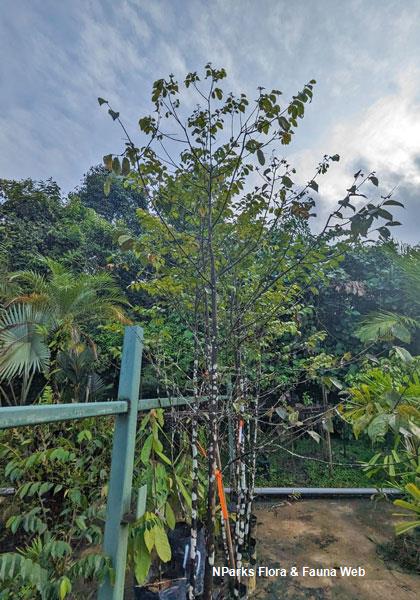
Back
Hopea odorata Roxb.
| Family Name: | Dipterocarpaceae |
| Common Name: | Chengal Pasir, Merawan Siput Jantan, Chengal Kampong, Cengal Pasir, Cengal Pulau, Telshur, Takhian-yai, Ironwood |
Name
Classifications and Characteristics
| Plant Division | Angiosperms (Flowering Seed Plants) (Dicotyledon) |
|---|---|
| Plant Growth Form | Tree (Big (>30m)) |
| Lifespan (in Singapore) | Perennial |
| Mode of Nutrition | Autotrophic |
Biogeography
| Native Distribution | Bangladesh, Myanmar, Laos, southern Vietnam, Cambodia, Thailand, the Andaman Islands and northern Peninsular Malaysia. |
|---|---|
| Native Habitat | Terrestrial |
| Preferred Climate Zone | Tropical |
| Local Conservation Status | Non-native (Horticultural / Cultivated Only) |
Description and Ethnobotany
| Growth Form | A medium-sized to large evergreen tree with a conical-shaped crown. It usually reaches a height of 25-30 m, but sometimes attains 40 m. The girth can be up to 4.5 m. |
|---|---|
| Trunk | Trunk is straight with short buttresses. The thick, slightly to deeply fissured outer bark is dark brownish-grey, and the inner bark is dull yellow. |
| Foliage | Alternate leaves are oblong to ovate-lanceolate with entire leaf margin, measuring about 7 - 14 by 3 - 7 cm, both surfaces glabrous, petiole measuring about 1.5 - 2 cm long. Prominent axillary domatia at the lower abaxial of leaf. |
| Flowers | Small, yellowish-white flowers are fragrant, bisexual and located in leaf axils or branch tips. They are radially symmetrical with triangular petals that have long ruffled tips. |
| Fruit | The small, brown fruit is a winged nut. The single-seeded nut is approximately egg-shaped with a pointed tip and may be covered in a shiny resin, measuring about 6 by 5 mm. It has 2 long wings (5.5 cm long) and 3 short wings which promote seed dispersal by wind. |
| Habitat | Found on deep rich soils in lowland tropical forests and evergreen forests at altitudes of up to 600 m. Usually located near streams and rivers. |
| Cultivation | It grows best in fertile, well-drained soil that is kept moist. Mulch the trees to conserve soil moisture. It is susceptible to attack by leaf chewers, stem borers and a seed-feeding weevil (Nanophyes). |
| Etymology | Genus name Hopea is named after Dr John Hope (1725 - 1786), who is a Scottish botanist of the Edinburgh Botanic Garden. |
| Ethnobotanical Uses | Cultural / Religious: Heritage Tree: There is currently 1 individual of Hopea odorata listed as Heritage Tree in Singapore. This tree can be found in Singapore Botanic Gardens. To find out more about this tree, please visit the Heritage Tree Register. |
Landscaping Features
| Desirable Plant Features | Ornamental Fruits, Fragrant |
|---|---|
| Landscape Uses | Suitable for Roadsides, Parks & Gardens, Small Gardens, Riverine, Pond / Lake / River, Shade Providing Tree / Palm |
Fauna, Pollination and Dispersal
| Pollination Method(s) | Biotic (Fauna) |
|---|---|
| Seed or Spore Dispersal | Abiotic |
Plant Care and Propagation
| Light Preference | Full Sun |
|---|---|
| Water Preference | Moderate Water |
| Plant Growth Rate | Moderate |
| Rootzone Tolerance | Moist Soils, Well-Drained Soils |
| Propagation Method | Seed |
Foliar
| Foliage Retention | Evergreen |
|---|---|
| Mature Foliage Colour(s) | Green |
| Mature Foliage Texture(s) | Smooth |
| Foliar Arrangement Along Stem | Alternate |
| Foliar Attachment to Stem | Petiolate |
| Foliar Shape(s) | Non-Palm Foliage (Ovate, Lanceolate, Oblong) |
| Foliar Venation | Pinnate / Net |
| Foliar Base | Cuneate |
| Leaf Area Index (LAI) for Green Plot Ratio | 3.0 (Tree - Intermediate Canopy) |
Floral (Angiosperm)
| Flower & Plant Sexuality | Bisexual Flowers |
| Flower Colour(s) | Yellow / Golden |
|---|---|
| Flowering Period | Every Few Years |
Fruit, Seed and Spore
| Mature Fruit Colour(s) | Brown |
|---|---|
| Mature Fruit Texture(s) | Smooth |
Image Repository
Others
| Master ID | 1666 |
|---|---|
| Species ID | 2959 |
| Flora Disclaimer | The information in this website has been compiled from reliable sources, such as reference works on medicinal plants. It is not a substitute for medical advice or treatment and NParks does not purport to provide any medical advice. Readers should always consult his/her physician before using or consuming a plant for medicinal purposes. |










.jpg)



_lowres.jpg)